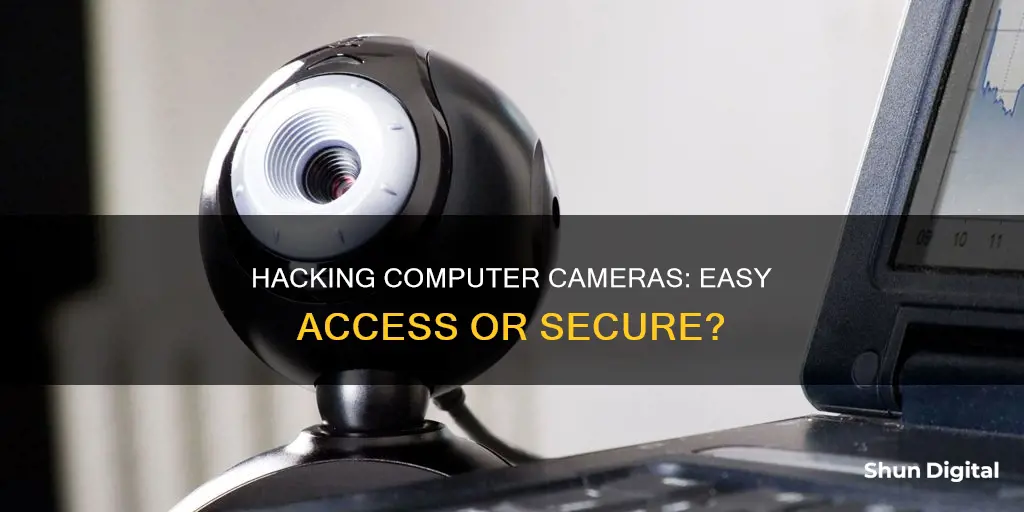
The idea of someone hacking into your computer camera and spying on you is no longer just a Hollywood plot. It's a real possibility and it's easier than you might think. Cybercriminals have multiple tools they can use to hack into your webcam, from exploiting existing spy software to using a Trojan virus to enter your system. However, there are also plenty of steps you can take to protect yourself and make sure your hardware is safe from hackers.
| Characteristics | Values |
|---|---|
| Difficulty Level | Not incredibly easy, but not difficult either |
| Hacker's Requirements | Foothold on the target PC/laptop |
| Methods | Spy software, exploiting internet connectivity, Trojans |
| Spy Software | Remote Administration Tools (RATs) |
| Spy Software Use Case | Theft tracking in corporate environments |
| Prevention | Tape over the camera, disable the camera |
| Indicator Light | Can be disabled by the hacker |
| Malware | Can be used to create an entry point |
| Antivirus | Can detect and prevent malware |
| Phishing | A common scam to install malware |
| Public Wi-Fi | Vulnerable to hacking |
| VPN | Can secure public Wi-Fi connections |
| Firewall | Can block suspicious connections |
| Passwords | Should be strong and not easily guessable |

Indicator light abnormalities
While most laptop and desktop cameras have an indicator light that turns on when the camera is in use, it is possible for hackers to circumvent this. In 2010, two high schools in the Lower Merion School District were sued for using the remote monitoring features of an application called LANrev without students' knowledge. The laptops, owned by the school and used by students for home study, contained security software with Theft Track, which enabled administrators to view the webcams remotely. Many students reported briefly seeing the webcam indicator light flicker on, but the district later admitted to taking 56,000 images of the students.
It is worth noting that the indicator light can be disabled, and it is not a completely reliable indicator of whether or not your camera is on. If you are concerned about webcam hacking, it is recommended to cover your camera with tape or a sliding cover when it is not in use. Additionally, keeping your computer's security and antivirus software updated can help protect against potential hacking attempts.
Extend Trail Camera Battery Life with These Tips
You may want to see also

New files
If you suspect that your computer camera has been hacked, there are several steps you can take to verify this. One way is to check for new files—most webcams will store new audio and video captures in a folder on your computer. Check this folder for any new additions that you don't remember creating. If you find unfamiliar files, this could indicate that your camera has been compromised.
To further investigate, you can check your browser extensions and applications. Reboot your computer and launch your browser. If the webcam light turns on, the issue may lie in a browser extension. You can deactivate your extensions one by one to identify the culprit. Additionally, you can launch applications one by one and observe if the webcam indicator lights up. This process may be time-consuming, but it can help pinpoint the source of the problem.
If you discover that your camera has been hacked, it is essential to take immediate action. Update your software and antivirus programs, use strong passwords, and be cautious when using public Wi-Fi. Covering your webcam with tape or a sliding cover is also an effective low-tech solution to prevent unwanted surveillance.
Adjusting Axis P3346 Cameras for Optimal Focus
You may want to see also

Malware
In some cases, hackers may trick victims into installing malware by disguising it as a legitimate application or software update. This is known as a "Trojan horse" or "social engineering" attack. Once installed, the malware can silently grant the hacker access to the victim's webcam, allowing them to capture pictures and videos without the victim's knowledge or consent.
To protect against malware-based webcam hacking, it is important to follow certain security practices. This includes keeping your operating system and security software up to date, using a firewall, creating strong passwords, avoiding suspicious links and emails, and using a virtual private network (VPN) when connecting to public Wi-Fi. Additionally, covering your webcam with tape or a specialized cover can prevent potential spying even if your webcam has been compromised.
Surveillance Cameras: Security, Safety, and Peace of Mind
You may want to see also

Firewall issues
Firewalls are a basic security measure that organisations of all sizes use to prevent data breaches and hacking. They act as a gatekeeper, monitoring traffic in and out of your network and blocking suspicious connections. However, firewalls are not impenetrable. Cybercriminals have a lot of experience circumventing them, and some insider threats can bypass them entirely.
Types of Firewall
There are two main types of firewall security: application gateways and packet-filtering gateways. Application gateways are proxies and cause computational problems due to heavy CPU usage. Packet-filtering devices are more common on busy networks. Some sellers try to combine the two types of firewall into one product.
Firewall Vulnerabilities
Firewalls are vulnerable to hacking, especially if they are misconfigured or not maintained properly. For example, a firewall administrator may configure a firewall to not respond to Internet Control Message Protocol (ICMP) echo requests to keep it safe from being hacked. However, some firewalls understand that a packet will expire when they reach the target host before the Access Control List (ACL) rules are applied, and they will send an ICMP TTL expired packet back to the hacker, leading to false positives.
Another tool that can be used to find open ports on a firewall is Firewalk. This tool evaluates a live system behind a firewall and discovers the permitted services and open ports without touching the system. It can also map the remote network behind the firewall. A hacker can use this information to create an accurate topology of the network behind the firewall.
Protecting Against Firewall Bypassing
While firewalls can be hacked or bypassed, there are still measures that can be taken to limit the risk. Using multiple firewall solutions at different levels can ensure that the same exploits and vulnerabilities won't work against all of your network firewalls. It is also important to stay on top of security patches and updates, as many attacks leverage known vulnerabilities. Setting strong password policies and applying multifactor authentication can also help to prevent account hijacking.
Cameras Behind Mad Men: Unveiling the Show's Visual Secrets
You may want to see also

Public Wi-Fi
- Avoid connecting your device to public Wi-Fi networks if possible. These networks are often less secure than private ones and may lack basic security measures, making it easier for hackers to infiltrate connected devices.
- Use a virtual private network (VPN) when connecting to public Wi-Fi. A VPN encrypts your internet traffic and routes it through a secure server, making it much harder for hackers to intercept your data or access your camera feed.
- Ensure your computer's firewall is enabled. A firewall adds a layer of protection between your device and the public Wi-Fi network, blocking unauthorized incoming connections and helping to prevent potential hacking attempts.
- Keep your operating system and security software up to date. Updates often include security patches that fix vulnerabilities, making it harder for hackers to exploit them and gain access to your camera.
- If your computer camera has physical covers or shutters, use them when not in use. This ensures that even if a hacker gains access to your camera, they cannot see anything.
- Be cautious when using public Wi-Fi networks, especially those that seem unsecured or poorly managed. If you must use public Wi-Fi, avoid accessing sensitive information or engaging in activities that require the use of your camera during that time.
- Finally, if you frequently connect to public Wi-Fi, consider using a separate, more secure device for activities that require the use of your camera. This way, even if one device is compromised, your other devices remain secure.
By following these instructions, you can significantly reduce the risk of your computer camera being hacked when using public Wi-Fi.
How to Find Out If Your Windows 7 PC Has a Camera
You may want to see also
Frequently asked questions
It's not incredibly easy, but if a hacker gains access to your computer, they can use that as a staging ground to hack your camera.
Hackers can take advantage of existing spy software, exploit an internet connectivity feature, or use a Trojan virus to enter your system.
There are several ways to protect your computer camera from being hacked, including:
- Using strong passwords
- Keeping your security software updated
- Using a VPN on public Wi-Fi
- Covering your camera when not in use







